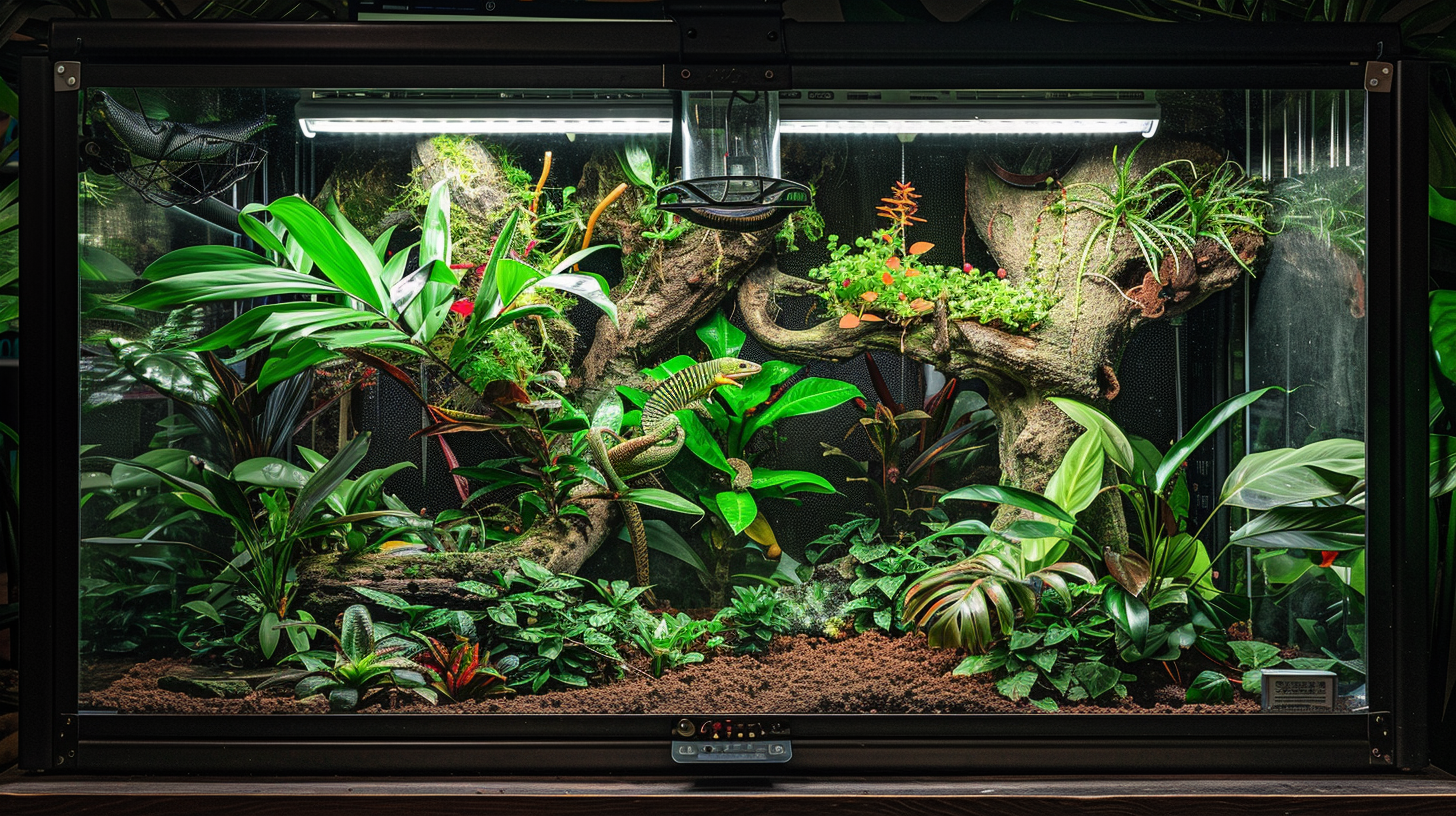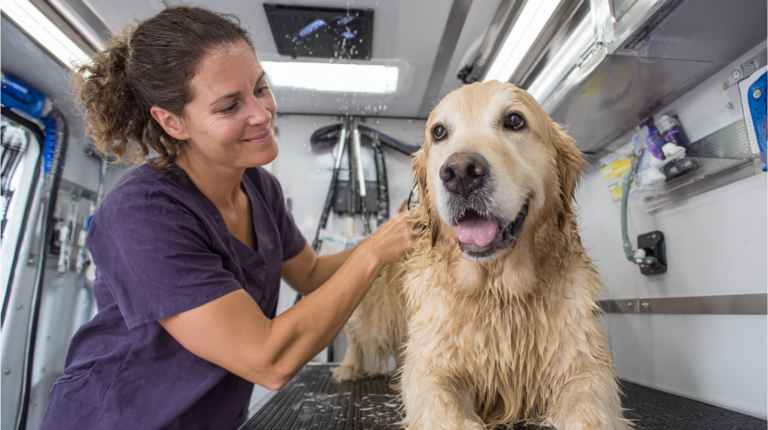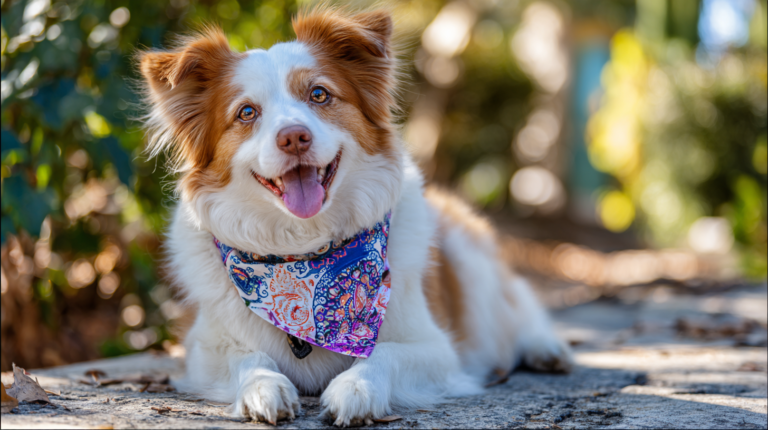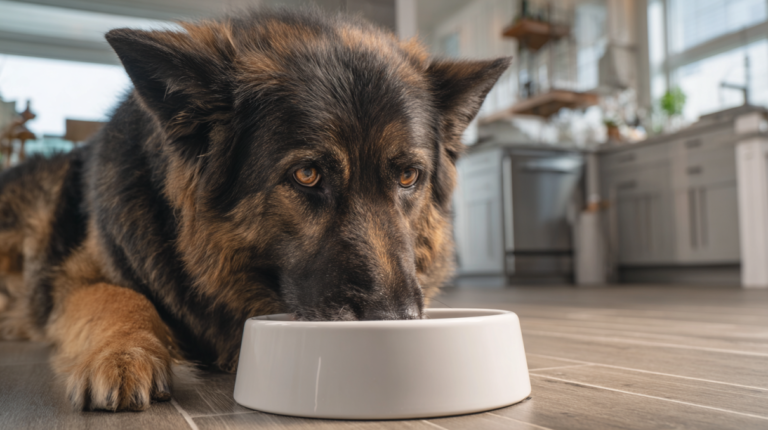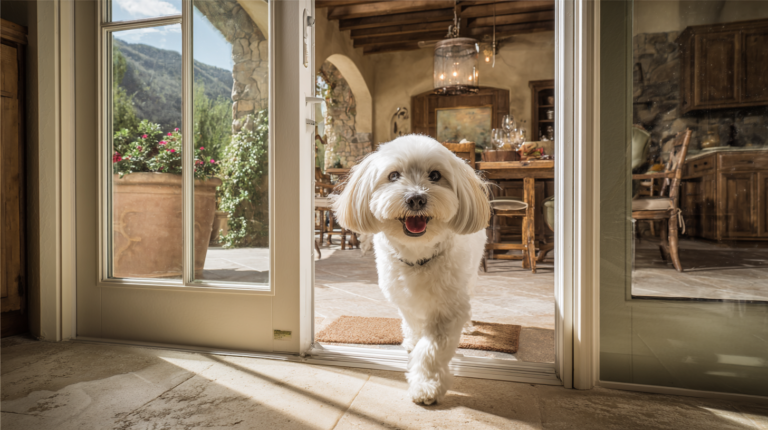Discover expert green anole enclosure setup tips for optimal reptile care. Learn habitat requirements, temperature control, and essential equipment for your green anole’s health.
Table of Contents
Did you know that 70% of reptile health issues stem from improper enclosure setup? Your green anole’s home isn’t just a container—it’s their entire world, and getting it right can mean the difference between a thriving pet and costly veterinary visits.
Green anoles (Anolis carolinensis) are among America’s most popular reptile companions, beloved for their vibrant color-changing abilities and relatively manageable care requirements. However, creating the perfect green anole enclosure requires more than just a glass tank and some decorations. These arboreal lizards have specific environmental needs that mirror their natural habitat in the southeastern United States.
Whether you’re a first-time reptile owner or looking to upgrade your current setup, this comprehensive guide will walk you through the eight essential elements every green anole enclosure needs. From proper lighting systems to humidity control, we’ll cover everything necessary to create a thriving environment that keeps your scaly friend healthy for their 4-8 year lifespan.
When I first set up my green anole enclosure in my Austin apartment, I made several rookie mistakes that taught me valuable lessons about these fascinating creatures. The difference between my initial basic setup and the optimized habitat I created later was remarkable—my anole became more active, displayed better colors, and showed natural behaviors I’d never seen before.
1. Choosing the Right Tank Size and Type
The foundation of any successful green anole enclosure starts with selecting appropriate housing. Unlike terrestrial reptiles, green anoles are arboreal creatures that spend most of their time climbing and basking in elevated positions.
Minimum Size Requirements:
- Single adult: 20-gallon long tank (30″ x 12″ x 12″)
- Pair of anoles: 40-gallon breeder tank (36″ x 18″ x 16″)
- Multiple anoles: Add 10 gallons per additional lizard
Height is more critical than floor space for green anole enclosures. A 40-gallon tall tank (20″ x 18″ x 24″) often works better than a 40-gallon long tank because it provides vertical climbing space. Screen-top terrariums offer excellent ventilation, which is crucial for preventing respiratory issues common in poorly ventilated enclosures.
Tank Material Considerations: Glass terrariums provide excellent visibility and maintain humidity better than screen enclosures. However, ensure adequate ventilation through screen tops and potentially side vents. All-screen enclosures work well in humid climates but may require additional humidity supplementation in dry environments.
Avoid plastic containers or aquariums without proper ventilation, as these can create stagnant air conditions leading to bacterial growth and respiratory problems. The enclosure should be escape-proof with secure, well-fitting lids, as green anoles are excellent climbers and surprisingly good at finding exit routes.
2. Essential Lighting Setup for Green Anole Health
Proper lighting represents one of the most critical aspects of green anole enclosure design. These diurnal lizards require specific types of lighting to maintain their health, behavior, and vibrant coloration.
UVB Lighting Requirements: Green anoles need UVB lighting with an output of 5.0-10.0 UVB. T5 HO (High Output) fixtures work better than compact fluorescent bulbs because they provide more even UVB distribution across the enclosure. Position UVB lights 6-12 inches from basking spots, depending on the bulb’s strength.
Replace UVB bulbs every 6-12 months, even if they still produce visible light. UVB output degrades over time, and inadequate UVB exposure leads to metabolic bone disease, a serious condition affecting calcium absorption.
Basking Light Setup: Provide a basking spot reaching 85-90°F using incandescent bulbs, ceramic heat emitters, or halogen spotlights. The basking light should create a thermal gradient, with the cool side maintaining temperatures around 75-80°F. Use adjustable fixtures to fine-tune temperatures based on seasonal changes and your home’s ambient temperature.
Photoperiod Management: Maintain a 12-hour light/dark cycle year-round, using timers to ensure consistency. This regular schedule helps regulate your anole’s circadian rhythms, promoting natural behaviors like feeding, basking, and sleep patterns.
During winter months, some keepers reduce lighting to 10 hours daily to simulate natural seasonal changes, though this isn’t strictly necessary for captive anoles’ health.
3. Temperature Control and Thermal Gradients
Creating proper temperature zones within your green anole enclosure ensures your pet can thermoregulate effectively—a critical behavior for their metabolism, digestion, and overall health.
Temperature Zone Requirements:
- Basking spot: 85-90°F
- Warm side: 80-85°F
- Cool side: 75-80°F
- Nighttime: 70-75°F
Use multiple thermometers positioned at different heights and locations to monitor these zones accurately. Digital thermometers with probes provide more reliable readings than stick-on strips, which often give inaccurate measurements.
Heating Equipment Options: Under-tank heaters (UTH) provide gentle bottom heat but shouldn’t be the primary heat source for arboreal species like green anoles. Overhead heating better mimics natural sunlight and encourages proper basking behavior. Ceramic heat emitters work well for nighttime heating when necessary, producing heat without light that could disrupt sleep cycles.
Seasonal Temperature Adjustments: During cooler months, you may need additional heating equipment to maintain proper temperatures. Conversely, summer heat might require reducing basking lamp wattage or improving ventilation. Room temperature significantly affects enclosure temperatures, so monitor and adjust heating accordingly.
Red or blue nighttime bulbs aren’t recommended, as recent research suggests reptiles can see these wavelengths, potentially disrupting their sleep patterns. If nighttime heating is necessary, use ceramic heat emitters or under-tank heaters controlled by thermostats.
4. Humidity Management for Optimal Health
Maintaining appropriate humidity levels in your green anole enclosure prevents dehydration, aids in proper shedding, and supports respiratory health. These southeastern natives naturally experience humidity levels between 60-80%.
Humidity Control Methods: Mist the enclosure 1-2 times daily using dechlorinated water, focusing on live plants and décor rather than directly spraying your anole. Automated misting systems provide consistent humidity for busy pet owners, though manual misting allows better observation of your pet’s behavior and enclosure conditions.
Live plants significantly contribute to humidity maintenance while providing natural climbing opportunities and hiding spots. Pothos, snake plants, and bromeliads work well in reptile enclosures and help maintain stable humidity levels through transpiration.
Monitoring Humidity Levels: Digital hygrometers provide accurate humidity readings essential for proper enclosure management. Place them at different heights, as humidity often varies between the top and bottom of the enclosure. Aim for 60-70% humidity during the day, with slight increases after misting.
Preventing Humidity Problems: Excessive humidity can lead to bacterial growth and respiratory issues, while insufficient humidity causes dehydration and shedding problems. Proper ventilation prevents stagnant air while maintaining appropriate moisture levels. If humidity consistently runs too high, increase ventilation or reduce misting frequency. If too low, add more live plants, increase misting, or place a shallow water dish in the enclosure.
During winter months when indoor heating reduces ambient humidity, you may need to mist more frequently or add a room humidifier near the enclosure.
5. Substrate Selection and Enclosure Flooring
Choosing appropriate substrate for your green anole enclosure affects both aesthetics and your pet’s health. The right flooring material should maintain humidity, allow for easy cleaning, and pose no ingestion risks.
Recommended Substrate Options: Cypress mulch provides excellent humidity retention and natural appearance while being relatively safe if accidentally ingested in small amounts. Coconut fiber (eco earth) offers similar benefits and creates a naturalistic forest floor appearance that complements live plants.
Paper towels or reptile carpet work well for quarantine situations or owners preferring easy maintenance. While less aesthetically pleasing, these options allow for simple cleaning and waste removal, making health monitoring easier.
Substrates to Avoid: Cedar and pine shavings contain aromatic oils that can irritate reptile respiratory systems. Sand poses impaction risks if ingested, and while adult green anoles rarely eat substrate, juveniles may accidentally consume sand while hunting prey.
Gravel or rocks as primary substrate can cause injury and don’t provide the natural forest floor environment green anoles prefer. Artificial grass or turf may harbor bacteria and doesn’t contribute to humidity maintenance.
Substrate Depth and Maintenance: Maintain substrate depth of 2-3 inches to allow for proper drainage and humidity retention. Spot-clean waste immediately and completely replace substrate monthly or when it becomes soiled or develops odors. Proper substrate maintenance prevents bacterial growth that could lead to skin infections or respiratory issues.
When using live plants, ensure proper drainage layers beneath the substrate to prevent root rot and standing water, which can create unhealthy bacterial conditions.
6. Climbing Structures and Environmental Enrichment
Green anoles are highly arboreal lizards requiring varied climbing opportunities to express natural behaviors and maintain physical fitness. A well-designed green anole enclosure incorporates multiple levels and textures for exploration.
Essential Climbing Elements: Natural branches provide the best climbing surfaces, offering varied diameters that exercise different muscle groups. Collect branches from oak, maple, or apple trees, ensuring they’re pesticide-free and properly sanitized by baking at 250°F for 30 minutes.
Commercial reptile vines and artificial plants work well as supplementary climbing structures, though natural elements are preferred when possible. Arrange climbing structures to create highways throughout the enclosure, allowing your anole to travel from the basking spot to water, hiding places, and different thermal zones without touching the ground.
Creating Vertical Territories: In the wild, green anoles establish territories that include specific basking spots, hunting areas, and retreat locations. Replicate this in captivity by creating distinct zones at different heights. The highest point should be the primary basking area, with cooler retreat spots at mid and lower levels.
Multiple basking spots prevent territorial disputes in multi-anole setups and provide options for temperature preference throughout the day.
Hiding Places and Security: Provide at least two hiding spots per anole—one on the warm side and one on the cool side of the enclosure. Natural cork bark hollows, artificial caves, or dense plant clusters work well. Green anoles need secure retreat spots to reduce stress and feel safe while sleeping or during handling sessions.
Live plants like pothos or philodendrons create natural hiding spots while contributing to humidity and air quality. Ensure all plants are reptile-safe and haven’t been treated with pesticides or fertilizers.
For more expert pet care tips and product recommendations, visit BlithePet.com — your trusted source for pet wellness.
7. Water Features and Hydration Systems
Providing adequate water sources in your green anole enclosure supports hydration while contributing to humidity maintenance. Green anoles obtain water through multiple methods, requiring thoughtful water feature design.
Water Dish Requirements: Shallow water dishes prevent drowning while providing drinking opportunities and humidity sources. Choose dishes 1-2 inches deep with textured sides or ramps for easy entry and exit. Change water every 2-3 days or immediately if contaminated with waste or substrate.
Position water dishes away from basking lights to prevent rapid evaporation and maintain stable humidity levels. Multiple small dishes work better than one large bowl, distributing humidity more evenly throughout the enclosure.
Dripping Systems: Many green anoles prefer drinking from water droplets rather than standing water, mimicking their natural behavior of drinking dew and raindrops from leaves. Simple drip systems using airline tubing and valves create moving water that attracts anoles and encourages drinking.
Commercial dripping systems or DIY setups using water bottles with small holes can provide this natural water source. Ensure proper drainage to prevent standing water accumulation that could lead to bacterial growth.
Natural Water Sources: Live plants with broad leaves collect misting water, creating natural drinking opportunities. Bromeliads naturally collect water in their centers, providing both drinking sources and humidity. However, change bromeliad water regularly to prevent bacterial growth.
Signs of Proper Hydration: Well-hydrated green anoles have plump, rounded bodies and bright, alert eyes. Dehydrated anoles may have sunken eyes, wrinkled skin, or lethargy. Proper shedding also indicates adequate hydration—stuck shed often results from insufficient humidity or dehydration.
8. Plant Selection and Living Décor
Incorporating live plants into your green anole enclosure creates a naturalistic environment while providing practical benefits including humidity maintenance, air purification, and behavioral enrichment.
Best Plant Choices for Green Anole Enclosures: Pothos (Devil’s Ivy) thrives in terrarium conditions and tolerates the temperature fluctuations common in reptile enclosures. Its trailing vines create excellent climbing opportunities and natural hiding spots throughout the enclosure.
Snake plants (Sansevieria) handle low-light conditions well and require minimal water, making them perfect for busy pet owners. Their upright growth pattern provides vertical structure without overwhelming smaller enclosures.
Bromeliads add tropical flair while creating natural water collection points. Choose smaller varieties like Neoregelia or Guzmania that won’t outgrow the enclosure quickly.
Plant Safety Considerations: All plants must be reptile-safe and pesticide-free. Research each species thoroughly, as some common houseplants like pothos are mildly toxic if ingested in large quantities, though green anoles rarely eat plants.
Quarantine new plants for 2-3 weeks before adding them to the enclosure, watching for pests or diseases that could affect your anole. Rinse all plants thoroughly to remove any chemical residues from the nursery.
Plant Care in Reptile Enclosures: Most reptile-safe plants adapt well to terrarium conditions, benefiting from the consistent humidity and warmth. However, UVB lighting may not provide enough intensity for some plants, requiring occasional rotation with plants kept under grow lights.
Prune plants regularly to prevent them from overwhelming the enclosure and blocking airflow. Remove dead or dying plant material immediately to prevent bacterial growth and maintain enclosure hygiene.
Artificial Plant Alternatives: High-quality artificial plants provide similar visual appeal and climbing opportunities without maintenance requirements. Choose realistic-looking options made from safe materials without small parts that could be ingested.
Mix artificial and live plants for the best of both worlds—live plants provide humidity and air quality benefits while artificial plants ensure consistent décor regardless of plant health issues.
Table 1 – Green Anole Enclosure Quick Setup Checklist:
| Component | Minimum Requirement | Recommended Upgrade | Notes |
|---|---|---|---|
| Tank Size | 20-gallon long | 40-gallon tall | Height more important than floor space |
| UVB Lighting | 5.0 UVB compact | 10.0 UVB T5 HO | Replace every 6-12 months |
| Basking Temperature | 85-90°F | 88°F optimal | Use thermometer with probe |
| Humidity Level | 60-70% | 65-75% | Monitor with digital hygrometer |
| Water Source | Shallow dish | Drip system + dish | Change every 2-3 days |
| Substrate | Paper towels | Cypress mulch | 2-3 inch depth |
| Hiding Spots | 2 minimum | 3-4 various sizes | One warm side, one cool side |
| Live Plants | Optional | Highly recommended | Pothos, snake plant, bromeliads |
Common Green Anole Enclosure Mistakes to Avoid
Even experienced reptile keepers can make mistakes when setting up green anole enclosures. Learning from these common errors saves time, money, and potentially your pet’s health.
Insufficient Vertical Space: Many new anole owners choose standard aquariums designed for fish, which emphasize floor space over height. Green anoles spend 90% of their time above ground level, making vertical space crucial for their physical and mental well-being.
Inadequate UVB Coverage: Placing UVB lights too far from basking spots or using outdated bulbs leads to metabolic bone disease. Compact fluorescent UVB bulbs often provide inadequate coverage compared to linear T5 or T8 fixtures that distribute UV rays more evenly across the enclosure.
Over-Misting and Poor Ventilation: Excessive humidity without proper airflow creates stagnant conditions promoting bacterial and fungal growth. Balance humidity needs with adequate ventilation through screen tops and strategic air circulation.
Using Inappropriate Heat Sources: Heat rocks and under-tank heaters as primary heat sources don’t provide the overhead warmth green anoles need for proper basking behavior. These nocturnal heating elements can also cause burns if malfunctioning.
Overcrowding: While green anoles can live in groups, overcrowding leads to stress, territorial disputes, and increased disease transmission. Provide adequate space and resources for each individual anole.
Table 2 – Temperature and Lighting Schedule:
| Time Period | Basking Light | UVB Light | Temperature Goal | Humidity Target |
|---|---|---|---|---|
| 7:00 AM – 7:00 PM | ON | ON | 85-90°F basking | 60-70% |
| 7:00 PM – 10:00 PM | OFF | OFF | 75-80°F ambient | 70-80% |
| 10:00 PM – 7:00 AM | OFF | OFF | 70-75°F nighttime | 70-80% |
| Misting Schedule | Morning (8 AM) | Evening (6 PM) | Monitor closely | Adjust seasonally |
When to Consult a Veterinarian
Recognizing when your green anole needs professional veterinary care can prevent minor issues from becoming serious health problems. Exotic veterinarians specialize in reptile care and understand the unique needs of green anoles.
Emergency Warning Signs: Labored breathing, mouth breathing, or wheezing indicates respiratory distress requiring immediate veterinary attention. Trauma from falls, stuck shed around toes or tail tips, and severe lethargy also warrant emergency care.
Prolapsed organs, bleeding, or seizures require immediate professional intervention. Don’t attempt home treatment for these serious conditions.
Routine Health Concerns: Persistent loss of appetite for more than a week, especially in adult anoles, suggests underlying health issues. Changes in defecation patterns, unusual color changes, or persistent shedding problems also indicate the need for veterinary evaluation.
Weight loss, visible parasites, or behavioral changes like increased aggression or unusual hiding may signal health problems requiring professional diagnosis.
Preventive Care: Annual wellness examinations help detect health issues before they become serious problems. Veterinarians can perform fecal examinations to check for parasites and provide guidance on optimal husbandry practices.
Establish a relationship with an exotic veterinarian before you need emergency care. Many general practice veterinarians lack reptile experience, making it important to locate specialists in your area.
Seasonal Adjustments and Long-Term Maintenance
Successful green anole keeping requires adapting care routines to seasonal changes and maintaining consistent long-term husbandry practices. Your enclosure setup should evolve with both environmental changes and your anole’s life stages.
Winter Adjustments: Indoor heating during winter months often reduces ambient humidity, requiring increased misting frequency or additional humidity sources. Monitor your anole’s behavior for signs of seasonal stress, such as reduced appetite or increased sleeping.
Some keepers reduce lighting periods during winter months to simulate natural seasonal changes, though this isn’t essential for captive anoles’ health. Maintain consistent temperatures regardless of outdoor weather conditions.
Summer Considerations: Increased ambient temperatures may require reducing basking lamp wattage or improving ventilation to prevent overheating. Monitor enclosure temperatures more frequently during heat waves, as room temperature significantly affects terrarium conditions.
Increased humidity during summer months may require reduced misting or improved ventilation to prevent excessive moisture levels that could promote bacterial growth.
Long-Term Equipment Maintenance: Replace UVB bulbs every 6-12 months, even if they still produce visible light. Keep spare bulbs on hand to avoid gaps in UV provision. Clean light fixtures regularly to maximize output efficiency.
Calibrate thermometers and hygrometers annually to ensure accurate readings. Digital instruments may drift over time, leading to incorrect environmental conditions.
Enclosure Upgrades: As you gain experience and observe your anole’s preferences, consider upgrading enclosure size or adding enrichment features. Adult anoles may benefit from larger territories, especially if you notice territorial behaviors or stress signs.
Document what works well in your setup and what could be improved. Take photos of successful arrangements for reference when cleaning or reorganizing the enclosure.
Table 3 – Troubleshooting Common Issues:
| Problem | Possible Causes | Solutions | Prevention |
|---|---|---|---|
| Low appetite | Stress, illness, wrong temperature | Check temps, vet exam | Stable environment |
| Stuck shed | Low humidity, dehydration | Increase misting, humidity box | Maintain 65-75% humidity |
| Lethargy | Wrong temperatures, illness | Adjust heating, vet check | Proper thermal gradient |
| Aggressive behavior | Overcrowding, territorial stress | Separate animals, larger space | Adequate territory size |
| Poor coloration | Stress, inadequate UVB | Improve lighting, reduce stress | Quality UVB, proper setup |
| Respiratory issues | Poor ventilation, wrong humidity | Improve airflow, adjust humidity | Balanced humidity/ventilation |
Myth-Busting: Common Green Anole Misconceptions
Several persistent myths about green anole care can lead to inadequate husbandry and health problems. Let’s address the most common misconceptions with science-based facts.
Myth #1: Green anoles only need heat, not UVB lighting. Fact: Green anoles are diurnal lizards requiring UVB radiation for vitamin D3 synthesis and calcium absorption. Without proper UVB exposure, they develop metabolic bone disease, a serious condition causing bone deformities and organ failure. Quality UVB lighting is just as important as proper heating.
Myth #2: Green anoles don’t drink water from dishes. Fact: While green anoles prefer drinking from water droplets, they readily use water dishes when properly positioned and maintained. Many captive anoles drink from bowls regularly, especially when dishes are kept clean and positioned away from heat sources that cause rapid evaporation.
Myth #3: Bigger enclosures stress green anoles. Fact: Appropriately sized enclosures with adequate hiding spots and climbing structures reduce stress rather than increase it. The key is providing security through hiding places and visual barriers, not limiting space. Green anoles are active lizards that benefit from room to establish territories and express natural behaviors.
Research-Based Care Guidelines: Recent studies on green anole behavior and physiology support evidence-based husbandry practices. Research published in the Journal of Herpetological Medicine and Surgery confirms that captive anoles with access to proper UVB lighting, thermal gradients, and environmental enrichment show better immune function and longer lifespans than those kept in basic setups.
Cost-Effective Setup Strategies
Creating an optimal green anole enclosure doesn’t require breaking the bank, but investing in quality essential equipment prevents expensive health issues down the road. Smart shopping and DIY solutions can reduce initial costs while maintaining high care standards.
Essential vs. Optional Equipment: Focus initial budgets on critical items: appropriate-sized enclosure, quality UVB lighting, reliable heating elements, and accurate monitoring equipment. These components directly impact your anole’s health and cannot be substituted with inferior alternatives.
Secondary purchases like automated misting systems, premium décor, and specialized substrates can be added gradually as budget allows. Start with functional basics and upgrade over time based on your anole’s specific needs and preferences.
Budget-Friendly DIY Options: Natural branches collected from safe trees provide excellent climbing structures at no cost. Ensure branches are properly sanitized and free from pesticides before use. Terra cotta pots create inexpensive hiding spots and can be partially buried in substrate for natural-looking caves.
Simple drip systems using aquarium airline tubing and valves cost significantly less than commercial misting systems while providing the moving water many anoles prefer. DIY humidity boxes using plastic containers with moss create microenvironments for shedding support.
Long-Term Value Investments: Quality UVB fixtures and thermostats represent higher upfront costs but provide years of reliable service and prevent expensive health problems. Cheap heating equipment often fails unexpectedly, potentially harming your anole and requiring emergency replacements.
Digital thermometers and hygrometers with data logging capabilities help track environmental trends and optimize husbandry practices, preventing problems before they affect your pet’s health.
FAQ Section
Conclusion:
Setting up an optimal green anole enclosure requires attention to detail, but the reward of watching these fascinating lizards thrive in a well-designed habitat makes every effort worthwhile. The eight essential elements covered in this guide—proper tank selection, lighting, temperature control, humidity management, substrate choice, climbing structures, water features, and live plants—work together to create an environment that supports your anole’s physical health and natural behaviors.
Remember that creating the perfect green anole enclosure is an ongoing process. As you observe your pet’s preferences and behaviors, you’ll discover opportunities to refine and improve their habitat. Some anoles prefer certain basking spots, while others may favor specific climbing routes or hiding places. Pay attention to these individual preferences and adjust accordingly.
The initial investment in quality equipment pays dividends in reduced veterinary costs and years of enjoyment watching your green anole display natural behaviors like territorial displays, color changes, and hunting activities. A properly maintained enclosure can provide a healthy environment for your anole’s entire 4-8 year lifespan.
Key Takeaways for Success:
- Prioritize vertical space over floor space in enclosure selection
- Invest in quality UVB lighting and replace bulbs regularly
- Maintain proper temperature gradients with reliable monitoring equipment
- Balance humidity needs with adequate ventilation
- Provide varied climbing opportunities and secure hiding spots
- Use live plants when possible for natural humidity and enrichment
- Monitor your anole’s behavior for signs of health or environmental issues
Creating an exceptional green anole enclosure demonstrates your commitment to responsible reptile keeping while providing your scaly companion with the best possible quality of life. The natural behaviors you’ll observe in a well-designed habitat—from territorial displays to hunting prowess—offer insights into these remarkable creatures that basic setups simply cannot provide.
Have you noticed specific behaviors or preferences in your green anole that have influenced your enclosure design? Every anole has unique personality traits that make observing them endlessly fascinating.
Have a similar experience with your pet? Share it in the comments below! Don’t forget to check out our other helpful guides at BlithePet.com.

